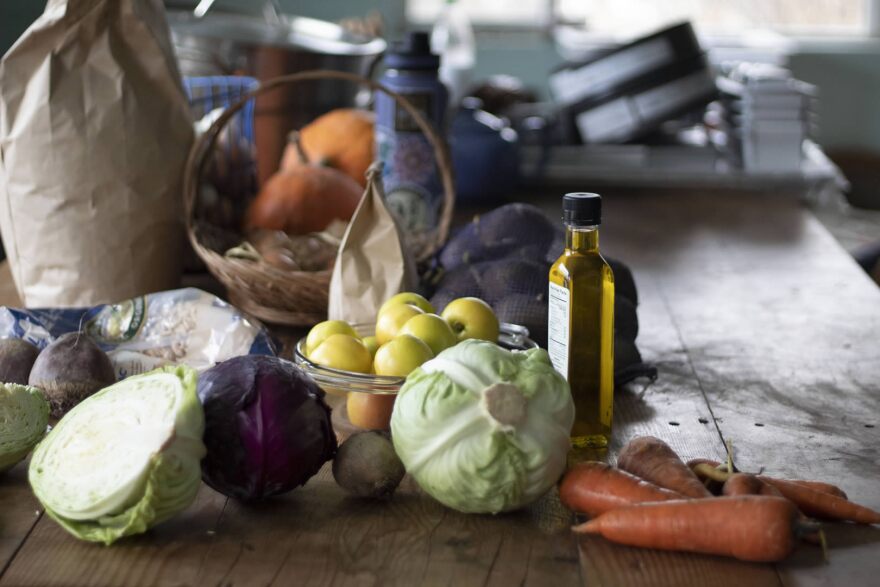Farmers and educators in the Bitterroot Valley are researching how to make a healthier and more local school lunch. The two-year research project in Hamilton wraps up this spring.
Laura Garber is standing in a large kitchen at Homestead Organics, a 14-acre farm she owns with her husband near Hamilton. There are three ovens, three prep tables and a dining table covered in a spread of local vegetables and eggs. The walls are lined with cookbooks and four people stir, chop and peel.
In Garber's experience, when Montanans hear “local food” they picture "cows and steak and huckleberries, but I don't know that people are thinking garbanzo beans and lentils and farro and barley and cheese and butter and honey."

Garber wants to change that. She is helping to run the Reimagining School Lunch local food test kitchen.
Garber’s farm is pooling money together with the Ravalli County Economic Development Authority (RCEDA) — and funding from the state’s agriculture department — to figure out how to make a school lunch with more local food. She and volunteers tinker with Montana-grown ingredients to develop those recipes in the test kitchen.
According to the state’s 2019-20 Montana Farm to School Annual report, these kinds of programs help kids eat healthy while supporting local farms and food systems. The report also says COVID-19 highlighted the need for farm-to-school programs as a way to solve food supply issues.
"There's so much that we're growing here that is amazing and yet we're exporting a lot, and then importing things from elsewhere," Garber says.
As Garber works on a meatless meatloaf featuring cheese, mushrooms and nuts, volunteer Felicia Ostler stirs a bowl of apple-cinnamon muffin batter.
"I am adding carrots, and it's made with honey instead of sugar so hopefully it gives kids a little healthier option for a sweet treat," Ostler explained.

Ravalli County was designated a “Food and Agriculture Development Center” two years ago by the Montana Department of Agriculture. It is one of eight agricultural network sites around the state that assist local farmers in growing their reach and profit.
The designation comes with access to state funding, access the county is using to build a new blueprint for how they're making school lunches, according to RCEDA Executive Director Julie Foster.
"Parents want their kids to eat healthy food, and it's a huge thing for our economy," Foster says. "I mean, we're always trying to figure out how to build Montana's economy. Why do we want to spend all this money elsewhere?"
She explained that tight budgets make it hard for school lunch programs to meet nutritional guidelines from the Montana Office of Public Instruction, and schools don’t have the same ability to cook a meal from scratch. Some can only heat up pre-packaged meals.
Aubree Roth, Farm to School Coordinator with MSU's Team Nutrition Program, says other schools in the state navigate these issues by implementing farm to school programs gradually.
"Some days, they're doing more of a processed heat-and-serve meal like chicken nuggets, and then another day of the week, they're doing roast beef that they've actually cooked themselves and carved themselves."
Roth's department found that farm to school programs in Montana reached over 25,000 kids across the state last school year, generating over $432,000 in local food purchases.

She and her team hope to see more schools serve local food for lunch and connect it to the curriculum. That could take shape as a school serves a local item and then works it into an activity each month.
"You'd be doing taste tests, going on farm field trips, doing school gardening, doing activities in and out of the classroom that really build on that foundation," Roth says.
Farm-to-school programs have slowly grown in Montana over the last three years. Roth’s department found over 57% of Montana schools participated in some way in programs during the 2019-2020 school year.
Ravalli County's state grant to expand farm-to-school meals ends in June, but Foster says the Department of Agriculture will keep the research and recipes as open-source information for schools across Montana.
She added the county will apply for another grant, this time to help build a production model that brings the food to public school students in the area.


